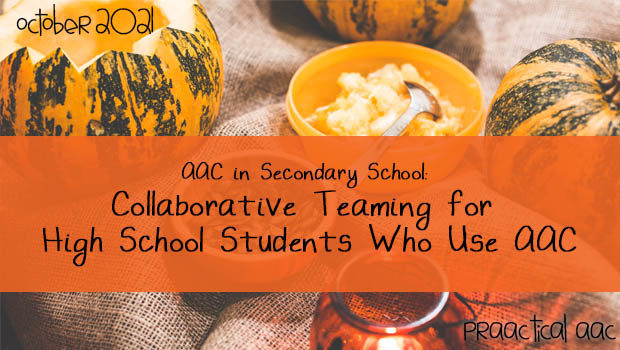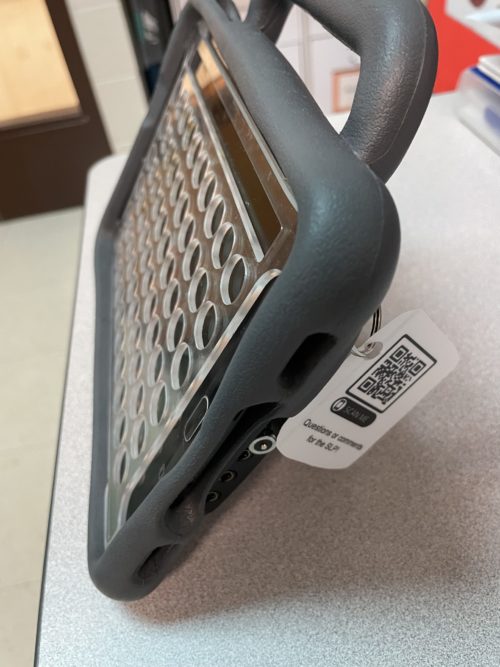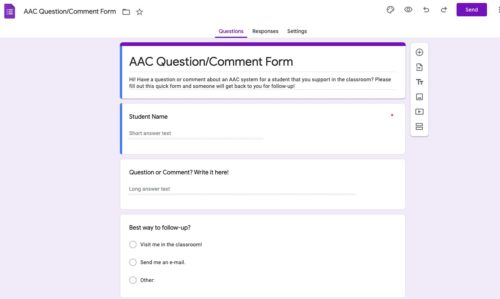AAC in Secondary School: Collaborative Teaming for High School Students Who Use AAC

 To be effective in supporting students who use AAC during their high school years, professionals have to work together as a collaborative team. Today, AAC SLP Ashley Larisey is back to discuss some of the most common challenges and share solution strategies. Ashley is an SLP at Community High School District 218 in Oak Lawn, Illinois. She is also an Adjunct Clinical Supervisor and Instructor at Saint Xavier University.
To be effective in supporting students who use AAC during their high school years, professionals have to work together as a collaborative team. Today, AAC SLP Ashley Larisey is back to discuss some of the most common challenges and share solution strategies. Ashley is an SLP at Community High School District 218 in Oak Lawn, Illinois. She is also an Adjunct Clinical Supervisor and Instructor at Saint Xavier University.
If you are new to this series, you might want to check out her previous posts in this series here.
Be sure to see her video on this topic at the end.
::::::::::::::::::::::::::::::::::::::::::::::::::::::::::::::::::::::::::::::::::::::::::::::::::::::::::::::::::::::::
Collaborative Teaming for High School Students Who Use AAC
Collaborative teaming is one of the most critical components in maximizing student outcomes for learners who use AAC. However, collaboration is not always easy. Whether it be finding the time, fostering a shared vision, or meaningful implementation, teams report various different roadblocks when it comes to collaborative teaming. Before we look at some of the possible solutions and ways to work collaboratively with other team members, it’s important to examine some of the barriers that might exist. While you’ll see a few examples of solutions to barriers below, it is important to note that this list is not all-encompassing.
4 Common Barriers and Potential Solutions
Planning and Preparation Time
Educators and clinicians are often working in settings with learners who have various different learning styles and benefit from individualized supports. Andzik, et. al (2017) examined some of the barriers reported by special education teachers specific to effective AAC implementation in their classrooms. Teachers reported varying levels of paid planning time within their days (0-90 minutes) to support the needs of all students within their classrooms, and several reported spending personal time and time on the weekends to plan and prepare. This ranged from a few hours to over 30 hours weekly.
Possible Solutions:
- If you are a speech-language pathologist, advocating for the use of a workload model or 3:1 model could help provide additional time for planning and preparation to support all students. You can find more information about the 3:1 model here and the workload calculator from ASHA here.
- Co-planning and Co-teaching – Splitting the responsibilities of planning and preparation with related service providers, general education teachers, and other stakeholders can work to reduce the load of planning and preparation. More importantly, it can help ensure educational relevance for related service providers and streamline implementation to ensure that all team members are on the same page. There are six different co-teaching models (team, parallel, station, alternative, one teach/one assist, one teach/one observe) to consider based on your learning intentions. This webinar from Annie Filla gives a great explanation of some of the different co-teaching models specific to AAC implementation.
Training
Training regarding AAC implementation is generally ongoing as the supports needed change over the course of time. Communication partners in the educational setting can often shift due to high turnover, and there may be different levels of training provided for all team members. For example, if general education teachers are not included in communication partner training experiences, then their ability to encourage the use of AAC within general education classrooms is negatively impacted. Additionally, if administrators are not knowledgeable regarding the supports needed for educators to maximize outcomes for students who use AAC, then they are less likely to fully understand the planning and preparation time that is needed to support learners across different settings (Andzik, 2017).
In addition to ongoing training needs, teams are constantly changing. This happens all the time – students transition between classrooms, staff are reassigned, and people change jobs. With each shift, new people will come onto the team with various levels of knowledge, skills, and attitudes (McNaughton, 2019). The stakeholders involved within each team as well as the amount of time they have designated for service can vary greatly from student to student. The only consistent team member on the team is the AAC user!
In addition, it is important to note that everyone has different learning styles. This quote from Building capacity in AAC: A person-centered approach to supporting participation by people with complex communication needs (McNaughton, et. al. 2019) highlights current needs in this area:
“Research is needed to better understand how people with different learning needs (e.g. people with complex communication needs, family members, professionals) and different levels of access to information resources can be best provided with individually appropriate instructional activities.” (p.9)
Possible Solutions:
- Communication partner training can be used to support new stakeholders in supporting AAC use within the classroom, home, or other relevant settings. These modules from Tabi Jones-Wohleber come complete with facilitator notes, supplemental handouts, video links, interactive discussion activities, and discussion resources.
- These training modules available from Project Core can be led by a facilitator (with facilitator notes included) or viewed independently with certificates of completion available after completing a short quiz at the end of each module. This flexibility can help accommodate different learning styles as well as potential scheduling barriers.
Shared Vision/Attitudes
Getting everyone on the “same page” is often reported as a big challenge. Different professionals working with students might all have different “goals” for that student within their individualized education program. When working with older students, we often see/hear terms such as “life skills” or “functional academics” used to describe learning activities. But what truly is important for older students who use AAC? How can we make sure that we are focusing on skills that maximize their learning experiences before they reach adulthood?
Possible Solutions:
- Person-Centered Planning – As students quickly approach adulthood and transition programs, person-centered planning guides stakeholders to ensure that students are engaging in meaningful learning experiences that will help them achieve their individualized goals. The AAC user is at the center of this planning, with the focus being on what is important to the individual and how they choose to spend their adult life. These choices are ongoing and may change over time. Tools like Talking Mats can help support AAC users who are emergent communicators in conveying their opinions. This presentation from Erin Sheldon from AAC in the Cloud titled AAC and Transition Planning: supporting all students to make decisions for the future offers excellent strategies for support AAC users throughout the person-centered planning process.
- Book clubs/blog clubs/podcast clubs – Using social opportunities to discuss books or podcasts can encourage team members to engage in a shared learning experience. If you have professional learning communities (PLCs) within your district, this can be a great way to learn more about a given topic with members of your team so that all students can benefit from the knowledge you have collectively gained.
Communication
With so many team members – how can everyone keep the lines of communication open to ensure collaboration is ongoing and productive? Stakeholders work in different settings and do not always have mutual times for in-person, ongoing collaboration. Additionally, communication styles vary just as learning styles do. You may be working with people who prefer e-mail, phone calls, or talking face to face. How can we balance the need for ongoing communication with communication styles?
Possible Solutions
- RAST Resources: RAST (Resources for AAC strategies and Tools) is a shared list of forms, surveys, strategies, data collection forms, and more that are available to print, download, and customize to meet the needs of various different teams. These can be shared with all team members and updated as needed.
- QR codes: When we review the research that indicates that implementation needs to address the various different learning styles of team members, we can look to provide ways for any team member to ask questions as they arise and receive feedback via their modality of choice. This QR code links to a google form with generic information about what support the stakeholder would like to request, as well as information about how they would prefer to receive the information.


Looking for more information regarding collaborative teaming? Check out the presentation here for additional tips on easy ways you can adjust your current practice to improve collaboration.
What are some of the strategies that you use to overcome implementation barriers? Share them below!
Resources
Andzik, Natalie R et al. “AAC Services in Schools: a Special Educator’s Perspective.” International journal of developmental disabilities 65.2 (2019): 89–97. Web.
McNaughton, David et al. “Building Capacity in AAC: A Person-Centred Approach to Supporting Participation by People with Complex Communication Needs.” Augmentative and alternative communication 35.1 (2019): 56–68. Web.
Filed under: Featured Posts, PrAACtical Thinking
This post was written by Carole Zangari
